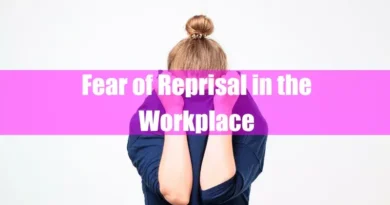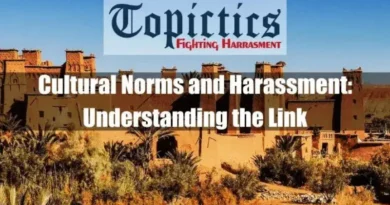I. Introduction
Fear of retaliation is the apprehension of negative consequences for speaking up about mistreatment. This can include unwanted behavior that makes you feel uncomfortable, unsafe, or disrespected. It’s a common reason why people stay silent about harassment, whether it happens at work, online, or anywhere else.
Harassment’s many forms, from jokes to unwanted advances, are often shielded by the fear of retaliation. Victims worry about job loss, social isolation, or even further abuse, creating a chilling effect that silences voices and perpetuates a harmful cycle. This article explores the fear of retaliation in harassment, its impact, and strategies to overcome it, fostering a culture of safe reporting and eliminating the shadow of reprisal.
II. Understanding the Fear of Retaliation

Before we dissect the intricate mechanisms of fear, let’s first establish a clear definition of “retaliation” in the context of harassment. It refers to any negative action against someone who reports or opposes harassment. This can manifest in blatant forms like threats, demotions, or physical harm or in more subtle ways like social exclusion, increased workload, or undeserved criticism.
Imagine walking through a minefield, unsure where the next explosive might be. That’s what fear of retaliation feels like for victims of harassment. The potential consequences can be paralyzing, leading to a range of psychological impacts:
- Anxiety and Fear: The constant worry about repercussions can keep victims on edge, impacting their sleep, concentration, and overall well-being.
- Depression and Helplessness: Feeling unsupported and silenced can breed a sense of hopelessness and despair, making it difficult to cope and seek help.
- Reduced Self-Esteem: Retaliation can confirm the perpetrator’s message of dominance and leave victims questioning their self-worth and ability to stand up for themselves.
Understanding the power dynamics at play is crucial here. Often, perpetrators hold positions of power at work, school, or online communities. This creates vulnerability for victims who depend on them for livelihood, grades, or social acceptance. The power imbalance fuels the fear of losing what little control victims have, further silencing their voices.
Let’s delve deeper into specific forms of retaliation:
- Direct Threats: Explicit warnings of job loss, physical harm, or social ostracization can be terrifying and silence even the most determined individual.
- Emotional Abuse: Belittling, gaslighting, and public humiliation can be just as damaging as physical threats, chipping away at the victim’s emotional well-being and confidence.
- Career Sabotage: Negative performance reviews, unfair assignments, or blocked career opportunities can harm someone’s professional life.
- Social Exclusion: Being ostracized or bullied by colleagues or social circles can be isolating and painful, adding another layer of hardship to the already existing trauma.
This is just a glimpse into the different ways retaliation manifests. Remember, these are not merely isolated incidents; they are tactics used to maintain power, silence victims, and perpetuate harmful behavior.
Related articles:
- Clarifying Consent in Professional Environments
- Explaining Sexual Favors Considering Harassment
- Demystifying Sexual Advances: Beyond Yes or No
III. Consequences of Fear of Retaliation
The chilling effect of fear of retaliation extends far beyond individual victims, creating a ripple effect with consequences for organizations, communities, and even broader societal issues. Let’s explore these consequences in detail:
A. Silenced Voices and Unchecked Harassment:
- Reduced Reporting: When victims fear retaliation, they are less likely to report harassment, allowing it to continue unchecked. This emboldens perpetrators and discourages others from speaking up, creating a culture of silence and impunity.
- Normalizing Harmful Behavior: Unreported harassment becomes normalized, leading to a society where such behavior is tolerated and even expected. This can have detrimental effects on workplace ethics, educational environments, and online communities.
B. Impact on Organizations and Communities:
- Toxic Workplaces: When retaliation occurs, trust within organizations erodes, leading to decreased morale, productivity, and employee retention. This creates a toxic environment where everyone feels vulnerable and hesitant to speak up.
- Damaged Reputations: Unaddressed harassment can lead to public scrutiny and damage an organization’s reputation, impacting its brand image, customer loyalty, and ability to attract top talent.
- Erosion of Community Trust: In online communities, fear of retaliation can stifle healthy discourse and create a hostile environment where diverse voices are silenced. This hinders community growth and discourages open and honest communication.
C. Legal and Societal Implications:
- Potential Legal Liabilities: Organizations that fail to address retaliation face legal risks, including lawsuits from victims and fines from regulatory bodies. This can have significant financial repercussions.
- Cultural Normalization of Misconduct: When retaliation goes unchallenged, it reinforces harmful societal norms that tolerate harassment and discourage reporting. This normalizes misconduct and hinders progress towards building a more equitable and inclusive society.
- Deterrence of Speaking Up: The chilling effect of retaliation has a ripple effect beyond the initial incident. Witnessing others face consequences for speaking up discourages potential bystanders from intervening in future harassment situations.
While these consequences paint a grim picture, it’s important to remember that we are not powerless.
Related articles:
- The Role of Empathy in Harassment
- How to Provide Anti-harassment Training in the Workplace
- How to Provide Anti-harassment Training in Schools
IV. Overcoming the Fear of Retaliation

Fear of retaliation may be powerful, but it mustn’t be insurmountable. Let’s explore different strategies and resources available to empower victims, create a supportive environment, and ultimately defeat the chilling effect of retaliation:
A. Building Individual Resilience and Empowerment:
1. Education and Awareness:
Understanding the dynamics of harassment and retaliation can equip individuals to recognize harmful behavior and navigate power imbalances. Resources like workshops, training, and online information can be crucial in this process.
2. Developing Support Networks
Building a strong support network of friends, family, colleagues, or online communities can provide victims with emotional support, guidance, and the courage to speak up.
3. Practicing Self-Care:
Prioritizing self-care through healthy coping mechanisms like mindfulness, exercise, and creative expression can build resilience and empower individuals to deal with the emotional fallout of harassment and retaliation.
4. Seeking Professional Help:
If needed, accessing professional mental health support can be invaluable in processing trauma, managing anxiety, and developing coping strategies.
B. Fostering a Culture of Safe Reporting:
1. Clear Policies and Procedures:
Organizations and communities need clear, accessible, and well-communicated policies on harassment and retaliation. Reporting procedures should be confidential, fair, and unbiased, ensuring swift and effective investigation and action.
2. Anti-Retaliation Measures:
Strong anti-retaliation policies and enforcement mechanisms are crucial to deterring perpetrators and assuring victims of their safety when reporting. These measures could include whistleblower protection, confidential reporting channels, and independent investigation procedures.
3. Bystander Intervention Training:
Equipping bystanders with skills to intervene safely and effectively in harassment situations can create a powerful support system for victims and send a clear message that harmful behavior won’t be tolerated.
4. Building Trust and Open Communication:
The key to breaking the silence and encouraging reporting is creating a trusting and open communication culture where everyone feels comfortable voicing concerns without fear of judgment or reprisal. This involves fostering inclusivity, respect, and open dialogue within organizations and communities.
C. Accessing Supportive Resources:
1. Hotlines and Help Centers:
Numerous hotlines and help centers offer confidential support and guidance to victims of harassment and retaliation. These resources can provide legal advice, emotional support, and information on reporting procedures.
2. Legal Aid:
Individuals facing retaliation may benefit from seeking legal aid to understand their rights and explore potential legal options.
3. Employee Assistance Programs (EAPs):
Many organizations offer confidential EAPs that provide counseling, legal guidance, and other support services to employees facing harassment or retaliation.
4. Online Communities:
Online communities and support groups can offer victims a sense of belonging and connection, allowing them to share experiences, find understanding, and access resources.
Remember, overcoming the fear of retaliation requires a multi-pronged approach. By empowering individuals, fostering a supportive environment, and utilizing available resources, we can create a world where everyone feels safe to speak up against harassment without fear of reprisal.
Related articles:
- Empowering Clear Communication Skills Against Harassment
- Explaining Verbal Harassment or Abuse in Various Settings
- Explaining Non-verbal Harassment or Abuse
- Explaining Physical, Visual, and Online Harassment
V. Expanding the Scope: Specific Examples and Global Perspectives

While we explored the general concepts of fear of retaliation in harassment, its impact varies depending on the specific type of harassment and the broader legal and cultural context. Let’s explore some key considerations:
A. Tailoring Strategies to Specific Harassment Types:
1. Workplace Harassment:
Power dynamics and concerns about job security can significantly affect workplace retaliation. Addressing these specific anxieties and providing clear reporting channels within organizations is crucial.
2. Sexual Harassment:
Fear of being labeled, victim-blaming, and societal stigmas can further silence victims of sexual harassment. Specific support groups, trauma-informed approaches, and anonymous reporting options can be especially helpful in such cases.
3. Cyberbullying:
The anonymity and pervasiveness of online harassment can create unique challenges in identifying and reporting perpetrators. Exploring online reporting mechanisms, promoting digital literacy, and fostering cyber-respectful communities are crucial steps.
B. International Perspectives on Retaliation Laws and Resources:
1. Variations in Legal Frameworks:
Anti-retaliation laws and enforcement mechanisms vary significantly across countries. It is important to highlight these differences and advocate for stronger global standards.
For Example:
- The United States: The US has a robust legal framework against retaliation, and federal laws like Title VII of the Civil Rights Act protect employees from retaliation for reporting harassment.
- China: Anti-retaliation laws are relatively new in China, and cultural emphasis on saving face can discourage victims from reporting harassment for fear of social repercussions.
2. Cultural Barriers to Reporting:
Societal norms and cultural taboos in certain regions can create additional barriers to reporting harassment and seeking support. Understanding these nuances and tailoring resources accordingly is vital.
For Example:
- Japan: Strict social hierarchies and indirect communication styles can make it difficult for victims, especially junior employees, to report harassment against superiors.
- The Middle East: Gender norms and societal stigma surrounding sexual harassment can prevent victims, particularly women, from coming forward.
3. Sharing Global Best Practices:
Learning from countries with stronger anti-retaliation measures and victim support systems can inform global progress in addressing this issue.
By acknowledging these complexities and tailoring strategies to specific contexts, we can create a more comprehensive and impactful approach to tackling the fear of retaliation in harassment on a global scale.
Also, read:
- 20 Quid Pro Quo Harassment Examples and How to Stop Them
- How to Prove Quid Pro Quo Harassment: 13 Powerful Evidences
- Quid Pro Quo Harassment vs. Hostile Work Environment Harassment
- Is Quid Pro Quo Illegal? 21 Accused Celebrities Examples
VI. Conclusion

The fear of retaliation casts a long shadow, silencing voices, perpetuating harmful behavior, and eroding trust within organizations and communities. However, understanding the dynamics, consequences, and available resources can empower us to overcome this chilling effect.
By building individual resilience, fostering safe reporting cultures, and utilizing supportive resources, we can create a world where speaking up about harassment is not an act of courage but a fundamental right exercised without fear of reprisal. Let’s remember that silence only grants power to the perpetrators. It’s time to break the silence, challenge the status quo, and build a culture where respect and safety prevail. Let’s stand together, empower one another, and create a world where everyone feels safe to speak their truth. This journey might be challenging, but it’s worth taking for ourselves, each other, and a future free from fear and harassment.
VII. FAQs
A. How does fear of retaliation differ for victims of sexual harassment compared to workplace bullying?
Victims of sexual harassment often face additional anxieties like victim-blaming and societal stigmas, leading to specific needs like trauma-informed support and anonymous reporting options. In contrast, workplace bullying might focus on anxieties about job security and require clear reporting channels within organizations.
B. What unique challenges do victims of cyberbullying face in reporting retaliation compared to traditional forms of harassment?
Cyberbullying’s anonymity and pervasiveness create difficulties in identifying perpetrators. Exploring online reporting mechanisms, promoting digital literacy, and fostering cyber-respectful communities are crucial steps to address the fear of retaliation in such cases.
C. How do anti-retaliation laws and resources vary across different countries?
Legal frameworks and enforcement mechanisms differ significantly. Highlighting these discrepancies and advocating for stronger global standards is crucial.
D. How can we address cultural barriers to reporting harassment and seeking support in certain regions?
Understanding societal norms and tailoring resources to specific cultural contexts is vital. This may involve raising awareness, building trust with local communities, and offering culturally sensitive support systems.
E. What can we learn from countries with stronger anti-retaliation measures and victim support systems?
Sharing global best practices can inform progress in addressing retaliation. Identifying and learning from successful national strategies can pave the way for more effective global solutions.
F. What are some additional resources for learning more about this topic?
- The National Sexual Violence Resource Center
- The Equal Employment Opportunity Commission (EEOC)
- StopBullying.gov
- The Cyberbullying Research Center
Also, read:
- Explaining Quid Pro Quo Harassment Under Title IX
- Quid Pro Quo Harassment: What It Is? Know Everything
- How to Prevent Quid Pro Quo Harassment: 20 Effective Ways
- What is Sexual Quid Pro Quo Harassment? An Ultimate Guide.









